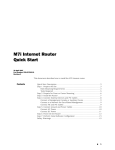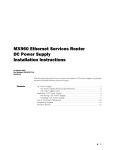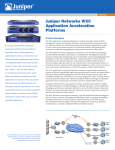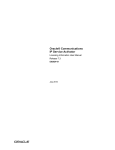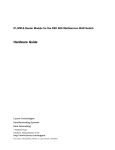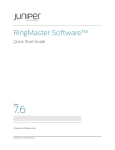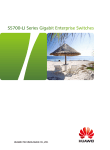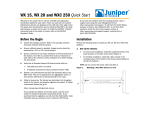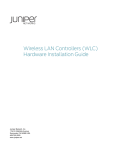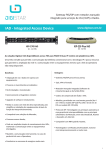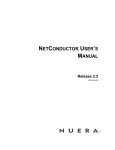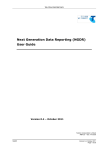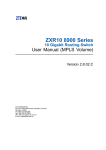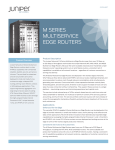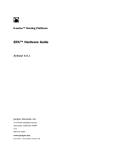Download Juniper Networks MX960 User's Manual
Transcript
Datasheet Juniper Networks MX960 Ethernet Services Router Product Description To ensure that the MX960 delivers the lowest cost per port without sacrificing performance, reliability, scalability or functionality, it has been purpose-built to optimize both switching and carrier-class Ethernet routing functionality. Service providers are experiencing a variety of processing and scaling demands for the growth of Ethernet traffic in their edge networks. Additionally, traditional carrier class elements typically not found in Ethernet platforms are Ethernet based services present a significant new revenue opportunity for service providers. These services include VPNs, point-to-point connectivity, high speed internet access and video-based offerings. With continuous technology advances and ongoing standards development, Ethernet is increasingly the technology of choice at the service provider edge. As an example of Juniper’s commitment to delivering Ethernet-centric solutions to meet the needs of next-generation networks and services, the MX960 offers unmatched scalability, performance, reliability and QoS for both business and residential services. The MX960 ESR is a high density Layer 2 and Layer 3 Ethernet platform designed for deployment in a number of service provider Ethernet edge scenarios. Examples of the wide range of Ethernet services provided by the MX960 include: • VPLS services for multi-point connectivity—native support for VPLS services • Virtual Leased Line (VLL) for point-to-point services—native support for point-to-point services now a requirement. These include hierarchical • RFC 2547.bis IP/MPLS VPN (L3VPN)—full support for MPLS VPNs throughout the Ethernet Network quality of service (QoS), logical interface • Video Distribution IPTV services scalability, High Availability features and MPLS • Ethernet Aggregation at the Campus/Enterprise Edge—supports dense 1 GE and 10 GE configurations as well as providing full L3 support for Campus Edge requirements feature richness. The MX960 Ethernet Services Router (ESR) was designed to address these specific Ethernet requirements. Powered by the industry leading JUNOS operating system and the high performance I-Chip, the MX960 delivers the scalability, reliability, performance and feature richness needed to meet the evolving • Ethernet Aggregation at the Multiservice Edge—supports up to 480 1 GE ports or 48 10 GE ports for maximum Ethernet density, along with full L2 and L3 VPN support for MSE applications Architecture and Key Components Business Ethernet Edge Terabit Core Broadband Ethernet Edge Multiplay aggregation & Multicast services Enterprise Ethernet services; VPLS, VPWS & L3 MX9 T-se requirements of the Carrier Ethernet market. 60 ries OLT VPLS MX9 60 T-se M series ries E32 T-se DSLA 0 M ries Telcos VPWS MX9 VPLS Service delivery and aggregation for Cable MSO Wireless 60 Cable Mode m Termina tion Cable MSOs 2 Features and Benefits The MX-series Extends JUNOS in the Network MPLS JUNOS is a world-class operating system with proven stability coupled with industrial-strength routing protocols, flexible policy language and leading MPLS implementation. When building your Ethernet-centric infrastructure, JUNOS can be a tremendous asset as a flexible and reliable operating system. An example of technical advancement and ongoing standards development that is driving the evolution of Ethernet in the service provider edge can be found in Multi Protocol Label Switching (MPLS) technology. MPLS has traditionally been found in network backbones to provide traffic engineering and allow the carriage of a wide range of Layer 2 and Layer 3 traffic such as IP, Frame Relay and ATM. Extending MPLS to the Ethernet edge brings benefits such as restoration techniques, Operations, Administration & Management (OA&M) diagnostic capabilities and QoS support for services that are sensitive to delay and delay variation. As an industry leader in the development and deployment of MPLS, Juniper Networks leads the way in making it possible for service providers to bring to market network architectures and services based on MPLS. The MX960 provides a wide range of MPLS features and functionality powered by the JUNOS operating system. The feature richness of JUNOS provides the MX960 an advantage over other operating systems that are either too immature to support the required MPLS feature breadth or architected in a monolithic fashion, making them too complicated or unwieldy to efficiently manage. Additionally, the MX960 is designed to lead the industry in the following areas: • Interface Scalability—as the largest form factor in the MX-series, the MX960 chassis provides up to 12 slots that can be populated with up to 480 ports of Gigabit Ethernet or up to 48 10 GE ports. • Advanced Packet Processing Performance—each slot provides line-rate 40 Gbps packet forwarding. • Service Flexibility—Juniper is an industry leader in both MPLS and VPLS, and the new MX960 Ethernet Services Router leverages the JUNOS operating system that is powering over 27,000 Juniper M-series routers currently deployed in over 600 service provider networks worldwide. The field-proven JUNOS provides the MX960 feature richness, stability, and service breadth not typically found in Carrier Ethernet platforms. • Advanced QoS—the MX-series features superior QoS at the interface level, which improves port density, can reduce costs and enables service providers to ensure that services receive the appropriate level of service regardless of traffic conditions. This enables providers to offer a variety of Layer 2 and Layer 3 services over Ethernet, such as VLAN/transparent LAN, L2/L3 VPNs, voice over IP and video over IP, with guaranteed service level agreements (SLAs). • Simple, Non-Disruptive Deployment—because the new MX-series utilizes the same JUNOS operating system that the world’s largest service providers have relied on for years, service providers can immediately take advantage of the latest Ethernet technology without the cost and risks associated with introducing a new operating system to the network. Customers’ familiarity, knowledge and integration of JUNOS in existing back-office systems allows them to drive down capital expenditure costs while rapidly rolling out Ethernet access networks and services. JUNOS Internet software runs on Juniper Networks MX-, M-, T-, and J-series routers. JUNOS software—the first routing operating system developed specifically for the Internet—is especially designed for the large production networks typically supported by service providers. JUNOS has been designed to configure the routing protocols that run on the MX960 and the properties of its interfaces. After a software configuration is activated, JUNOS has been designed to monitor the protocol traffic passing through the MX-series and to troubleshoot protocol and network connectivity problems. JUNOS software runs on the Routing Engine and consists of processes that: • Support Internet routing protocols • Control the MX-series interfaces • Control the routing of each MX-series chassis • Provide an interface for system management JUNOS full suite of industrial-strength routing protocols, flexible policy language, and leading MPLS implementation efficiently scales to large numbers of network interfaces and routes. MX960 VPNs JUNOS supports several types of VPNs: • Layer 2 VPNs—linking a set of sites sharing common routing information, and whose connectivity is controlled by a collection of policies. A Layer 2 VPN is not aware of routes within a customer’s network. It simply provides private links between a customer’s sites over the service provider’s existing public Internet backbone. • Layer 3 VPNs—linking a set of sites that share common routing information, and whose connectivity is controlled by a collection of policies. A Layer 3 VPN is aware of routes within a customer’s network, requiring more configurations on the part of the service provider than a Layer 2 VPN. The sites that make up a Layer 3 VPN are connected over a service provider’s existing public Internet backbone. • Interprovider VPNs—supplying connectivity between two VPNs in separate autonomous systems (ASs), this functionality could be used by a VPN customer with connections to various ISPs, or different connections to the same ISP in various geographic regions. • Carrier-of-Carrier VPNs—allowing a VPN service provider to supply VPN service to a customer who is also a service provider. The latter service provider supplies Internet or VPN service to the end customer. 3 Advantage Features Benefits High Availability • Fully redundant hardware • T he MX960 design provides the highest level of redundancy and resiliency to ensure that critical services and customers stay connected. (Cooling, power supplies, Routing Engines, Switch Control Boards) •E nables service providers to maximize revenues and ensure customer satisfaction. • Modular Operating System • Separate Data and Control Planes • Graceful Restart • Non-stop Routing • MPLS FRR • VPLS Multi-homing High Performance Powered by Juniper’s next-generation I-chip ASIC, the MX960 features include: • Enhanced QoS capabilities Industry leading performance enables the MX960 to satisfy critical applications at the edge, including voice, video and data. • Additional packet processing flexibility •S caling enhancements including route lookup, next hop, IFL scaling, and interface accounting •A dditional microcode capacity that provides headroom for the next three-to-five years of JUNOS features • Enhanced multicast performance Service Flexibility Simultaneous support for Layer 2 and Layer 3 Ethernet services: VPLS, RFC 2547bis IP/MPLS VPNs, Triple Play services MX960 Specifications Specification Physical Dimensions (W x H x D) Weight (lbs/kgs) Power (AC, DC) Operating Temperature Humidity EMC Description 17.5 x 27.8 x 23.5 in 44.5 x 70.5 x 59.7 cm Chassis: 138 lbs / 62.7 kgs Fully Configured: 334 lbs / 151.8 kgs DC power: -48V, -60V DC AC power: 200 to 240V AC 32° to 104° F / 0° to 40° C 5% to 90% noncondensing humidity Approvals Safety Approvals • CAN/CSA-22.2 No. 60950-00/UL 1950 Third Edition, Safety of Information Technology Equipment • EN 60825-1 Safety of Laser Products - Part 1: Equipment Classification, Requirements and User’s Guide • EN 60950 Safety of Information Technology Equipment Immunity • EN 61000-3-2 Power Line Harmonics • EN 61000-4-2 ESD • EN 61000-4-3 Radiated Immunity • EN 61000-4-4 EFT • EN 61000-4-5 Surge • EN 61000-4-6 Low Frequency Common Immunity • EN 1000-4-11 Voltage Dips and Sags Providing enterprise and residential services from a common platform increases service breadth and optimizes OPEX and CAPEX. • AS/NZS 3548 Class A (Australia/New Zealand) • BSMI Class A (Taiwan) • EN 55022 Class A Emissions (Europe) • FCC Part 15 Class A (USA) • VCCI Class A (Japan) NEBS • GR-63-Core: NEBS, Physical Protection • GR-1089-Core: EMC and Electrical Safety for Network Telecommunications Equipment ETSI • ETS-300386-2 Telecommunication Network Equipment Electromagnetic Compatibility Requirements Management Element Management: J-Web Graphical User Interface Policy Management: SDX-300 Service Deployment System, JUNOScope IP Service Manager Third Party Management Applications: Dorado, InfoVista, Micromuse, WANDL SNMP: SNMP v2/v3 bilingual agent support Ordering information Model Number Model Name and Description MX960BASE-AC MX960BASE-DC MX960BASE-PREM-AC MX960-BASE-PREM-DC RE-S-1300-2048-BB RE-S-2000-4096-UPG-BB RE-S-1300-2048-R RE-S-2000-4096-R MX960-PWR-DC-R MX960-PWR-AC-R MX960-SCB-R DPCE-R-40GE-SFP DPCE-R-4XGE-XFP DPCE-X-40GE-SFP DPCE-X-4XGE-XFP DPCE-R-Q-40GE-SFP DPCE-R-Q-4XGE-XFP DPCE-X-Q-40GE-SFP DPCE-X-Q-4XGE-XFP MX960 Line Card Chassis: 12+2 slot chassis with cooling system, Backplane, 2 Switch Control Boards (SCBs), 1 Routing engine, 3 AC Power supplies, 2 Fan Trays MX960 Line Card Chassis: 12+2 slot chassis with cooling system, Backplane, 2 Switch Control Boards (SCBs), 1 Routing engine, 2 DC Power supplies, 2 Fan Trays MX960 Line Card Chassis: 12+2 slot chassis with cooling system, Backplane, 2 Switch Control Boards (SCBs), 2 Routing engines, 4 AC Power supplies, 2 Fan Trays MX960 Line Card Chassis: 12+2 slot chassis with cooling system, Backplane, 2 Switch Control Boards (SCBs), 2 Routing engines, 4 AC Power supplies, 2 Fan Trays Routing engine with 1.3 GHz CPU and 2 GB memory, Base Bundle Routing engine with 2 GHz CPU and 4 GB memory, Base Bundle Routing engine with 1.3 GHz CPU and 2 GB memory, Redundant Routing engine with 2 GHz CPU and 4 GB memory, Redundant MX960 DC Power Entry Module, Redundant MX960 AC Power Entry Module, Redundant MX960 Control Board, Redundant 40x1 GE L2/L3 capable 4x10 GE L2/L3 capable 40x1 GE L2+ capable 4x10 GE L2+ capable 40x1 GE L2/L3 capable board with enhanced queuing 4x10 GE L2/L3 capable board with enhanced queuing 40x1 GE L2+ capable board with enhanced queuing 4x10 GE L2+ capable board with enhanced queuing About Juniper Networks Juniper Networks, Inc. is the leader in high-performance networking. Juniper offers a high-performance network infrastructure that creates a responsive and trusted environment for accelerating the deployment of services and applications over a single network. This fuels highperformance businesses. Additional information can be found at www.juniper.net. CORPORATE HEADQUARTERS AND SALES HEADQUARTERS FOR NORTH AND SOUTH AMERICA Juniper Networks, Inc. 1194 North Mathilda Avenue Sunnyvale, CA 94089 USA Phone: 888.JUNIPER (888.586.4737) or 408.745.2000 Fax: 408.745.2100 www.juniper.net EUROPE, MIDDLE EAST, AFRICA REGIONAL SALES HEADQUARTERS Juniper Networks (UK) Limited Building 1 Aviator Park Station Road Addlestone Surrey, KT15 2PG, U.K. Phone: 44.(0).1372.385500 Fax: 44.(0).1372.385501 Copyright 2007 Juniper Networks, Inc. All rights reserved. Juniper Networks, the Juniper Networks logo, NetScreen, and ScreenOS are registered trademarks of Juniper Networks, Inc. in the United States and other countries. JUNOS and JUNOSe are trademarks of Juniper Networks, Inc. All other trademarks, service marks, registered trademarks, or registered service marks are the property of their respective owners. Juniper Networks assumes no responsibility for any inaccuracies in this document. Juniper Networks reserves the right to change, modify, transfer, or otherwise revise this publication without notice. 100186-004 Oct 2007 EAST COAST OFFICE Juniper Networks, Inc. 10 Technology Park Drive Westford, MA 01886-3146 USA Phone: 978.589.5800 Fax: 978.589.0800 ASIA PACIFIC REGIONAL SALES HEADQUARTERS Juniper Networks (Hong Kong) Ltd. 26/F, Cityplaza One 1111 King’s Road Taikoo Shing, Hong Kong Phone: 852.2332.3636 Fax: 852.2574.7803 To purchase Juniper Networks solutions, please contact your Juniper Networks sales representative at 1-866-298-6428 or authorized reseller.




